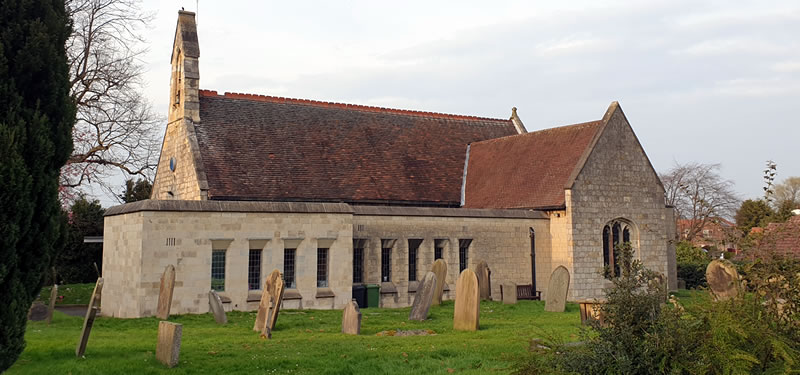We are two churches - St Thomas's, Osbaldwick and St James's, Murton whose aim is to offer worship to God; and love, care and support to the whole community.
St Thomas's Church
St Thomas's Church, Osbaldwick is mentioned three times in the Domesday Book as Osboldewic. It is named after Osbald, an earl in the kingdom of Northumbria. The history of St Thomas’s Church goes back nearly as far, to the 12th century. Within the church there are several reminders of its great age – the windows on the North wall date from the 12th, 13th and 14th centuries, and the 15th century East Window also remains, although re-sited in the 1960s in the South Transept wall.

During its life the church has undergone three major restorations or re-orderings. The first, in 1877, changed the building from a 'wretched condition', according to the Parish Almanac of 1897, where it was 'most unsightly and as a place of divine worship the church was uninviting as it possibly could be'. The architect for this work was J.A. Scott, son of the celebrated Sir Gilbert Scott.
The second major reordering, in 1967, saw the addition of the South transept, vestry, porch, WC and heating system. The interior height of the building was reduced by means of adding a vaulted ceiling. The third reordering, completed in 2005, greatly improved the entrance foyer, provided a kitchen and replaced the pews with comfortable seating. This has enhanced the versatility of the Church as both a place of worship and a social centre for the whole community.
A feature of St Thomas’s Church is the repeated use of the triple cross motif. The principal example is the cross hanging above the altar, given in 1967. This is designed to provide a ’cross’ focus for worshippers in both the Nave and the South transept and also along the 'line of the sacraments'. The motif can also be seen in the windows and the Vicar's prayer desk. The octagonal altar and the rails were made from the original 17th century woodwork of the church prior to the 1897 renovation. This architectural design aligned the symbols of the three main sacraments of Baptism (the font), the Word (lectern) and the Eucharist (altar).
The Mary Ward Memorial Stone was brought in from outside the church and was mounted in the South wall of the Nave. In the North West corner of the churchyard can be found the very simple plain gravestone of Eliza Raine from the early 19th Century.
The church is open and welcomes visitors every day throughout the year.
St James's Church
The village of Murton is mentioned in the Domesday Book of 1086, and although the origins of the Church are unknown, Nikolas Pevsner (in his The Buildings of England. Yorkshire: The North Riding, 1966) suggests that some of the masonry and the south doorway might suggest a date of circa 1200. St James’s is a small church, squeezing in just 54 people. As little appears to have been altered during its long life, only a few facts exist to document its history.
The Chantry Survey of 1547 records that 'There is a chapel of ease at Murton within the prebend of Osbaldwick whereof John Straker is incumbent by distance from the parish church one myle having neither goods nor plate. There is certaine copyhold land belongs to the same to the yearly value of 8s.' Nothing further is recorded until 1834 when a violent storm damaged the roof of the Church, rendering it unfit for use. There was a dispute over who was responsible for repair, which was not resolved, and as a result the church remained a ruin for the rest of the nineteenth century. For some of this time it served as a pig sty.

From 1912-1914, James Creaser, Edwin Draper, the Vicar and others raised money through concert parties for its restoration and St James was rededicated on 9 November 1914. The font in the west wall was taken out of Osbaldwick Church in about 1867 and later found in the churchyard. It was installed in Murton Church in about 1950. Its style suggests it may date from the 12th century. Apart from these changes and the introduction of electricity, St James’s Church appears to have changed little if at all over the centuries. As such it represents a valued and reassuring constant in our changing times. The little church makes a unique contribution to our communities through its simple, peaceful and intimate character, and inspires deep affection amongst locals and visitors alike.
Murton Centenary Project
In 2012, a Centenary Appeal was launched to raise funds for a much needed modernisation including a welcome lobby, toilet facilities and a kichenette in the church. These improvements were intended to enable the whole community to use the church for a wide variety of social activities.
An ambitious social programme consisting of over 20 events demonstrated the potential of the space as a valued community facility and attracted significant grants from local and national charities. When awarding one of their grant, the National Churches Trust wrote:
St James's Church appears to have changes little, if at all, over the centuries. As such it represents a valued and reassuring constant in today's changing times. The little church makes a unique contribution to the community through its simple, peaceful and intimate character, and inspires deep affection amongst locals and visitors alike.
To mark the actual centenary, a Service of Thanksgiving and Rededication was held on 9th November 2014 with the Bishop of Selby, the Right Reverent John Thomson, as preacher. Rebuilding work began in early 2016 and the facilities were officially opened by the Bishop of Selby on 31st July 2016.
The church is open and welcomes visitors every day throughout the year.
